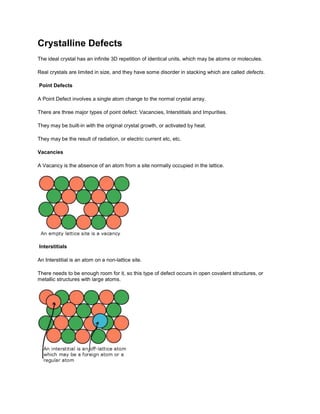
Crystalline Defects: Point, Line, Planar & Volume
- 1. Crystalline Defects <br />The ideal crystal has an infinite 3D repetition of identical units, which may be atoms or molecules.<br />Real crystals are limited in size, and they have some disorder in stacking which are called defects.<br /> Point Defects <br />A Point Defect involves a single atom change to the normal crystal array.<br />There are three major types of point defect: Vacancies, Interstitials and Impurities.<br />They may be built-in with the original crystal growth, or activated by heat.<br />They may be the result of radiation, or electric current etc, etc.<br />Vacancies<br />A Vacancy is the absence of an atom from a site normally occupied in the lattice.<br /> Interstitials<br />An Interstitial is an atom on a non-lattice site.<br />There needs to be enough room for it, so this type of defect occurs in open covalent structures, or metallic structures with large atoms.<br /> <br />Impurities<br />An Impurity is the substitution of a regular lattice atom with an atom that does not normally occupy that site.<br />The atom may come from within the crystal, (e.g. a Chlorine atom on a Sodium site in a NaCl crystal) or from the addition of impurities.<br />The concentration of point defects in a crystal is typically between 0.1% and 1% of the atomic sites, however extremely pure materials can now be grown.<br />The concentrations and movement of point defects in a solid are very important in controlling color and deformation.<br />Line DefectsDislocation<br />A Dislocation is a line discontinuity in the regular crystal structure.<br />There are two basic types: Edge dislocations, and Screw dislocations.<br />•An Edge dislocation in a Metal may be regarded as the insertion (or removal) of an extra half plane of atoms in the crystal structure.<br />In Ionic and Covalent solids edge dislocations involve extra half planes of unit cells.<br />The regions surrounding the dislocation line are made of essentially perfect crystal.<br />The only severe disruption to the crystal structure occurs along the dislocation line (perpendicular to the page).<br />Note that perpendicular to the page, the line may step up or down. These steps are known as jogs.<br />•A Screw Dislocation changes the character of the atom planes.<br />The atom planes no longer exist separately from each other.<br />They form a single surface, like a screw thread, which quot; spiralsquot; from one end of the crystal to the other.<br />(It is actually a helical structure because it winds up in 3D, not like a spiral that is flat.)<br />In the average crystal structure, there are ~1012 m of dislocation lines per m3 of crystal.<br />Combinations of edge and screw dislocations are often formed as edge dislocations can be formed by branching off a screw dislocation.Planar Defects<br />A Planar Defect is a discontinuity of the perfect crystal structure across a plane.<br />Grain Boundaries<br />A Grain Boundary is a general planar defect that separates regions of different crystalline orientation (i.e. grains) within a polycrystalline solid.<br />The atoms in the grain boundary will not be in perfect crystalline arrangement.<br />Grain boundaries are usually the result of uneven growth when the solid is crystallizing.<br />Grain sizes vary from 1 µm to 1 mm.Tilt Boundaries<br />A Tilt Boundary, between two slightly mis-aligned grains appears as an array of edge dislocations.<br />Twin Boundaries<br />A Twin Boundary happens when the crystals on either side of a plane are mirror images of each other.<br />The boundary between the twinned crystals will be a single plane of atoms.<br />There is no region of disorder and the boundary atoms can be viewed as belonging to the crystal structures of both twins<br />Twins are either grown-in during crystallization, or the result of mechanical or thermal work. <br />Microcracks<br />A Microcrack occurs where internal broken bonds create new surfaces.<br />They are about 10 µm in size and there is a tendency to form on the surface of a solid rather than in the bulk.<br />They also form at grain boundaries and other regions of disorder.<br />The region across which the bonds are broken is known as the separation plane.<br /> Micro cracks are formed when there is abrasion (or impacts) with dust particles.<br />They are important in determining how, and where, a solid may fracture.<br /> When a crystal has more than one type of atom, there will be Chemical as well as Physical disorder in the grain-boundaries.<br />Volume Defects <br />Volume defects are Voids, i.e. the absence of a number of atoms to form internal surfaces in the crystal.<br />They have similar properties to micro cracks because of the broken bonds at the surface.<br />
